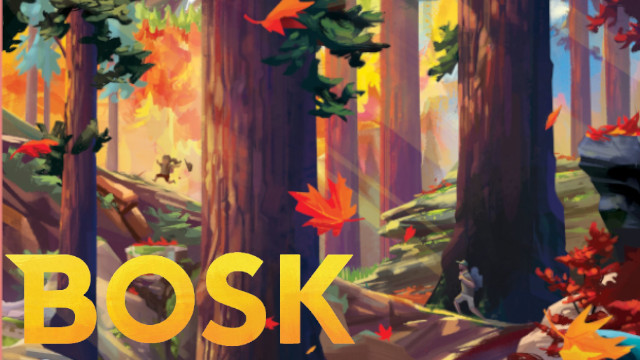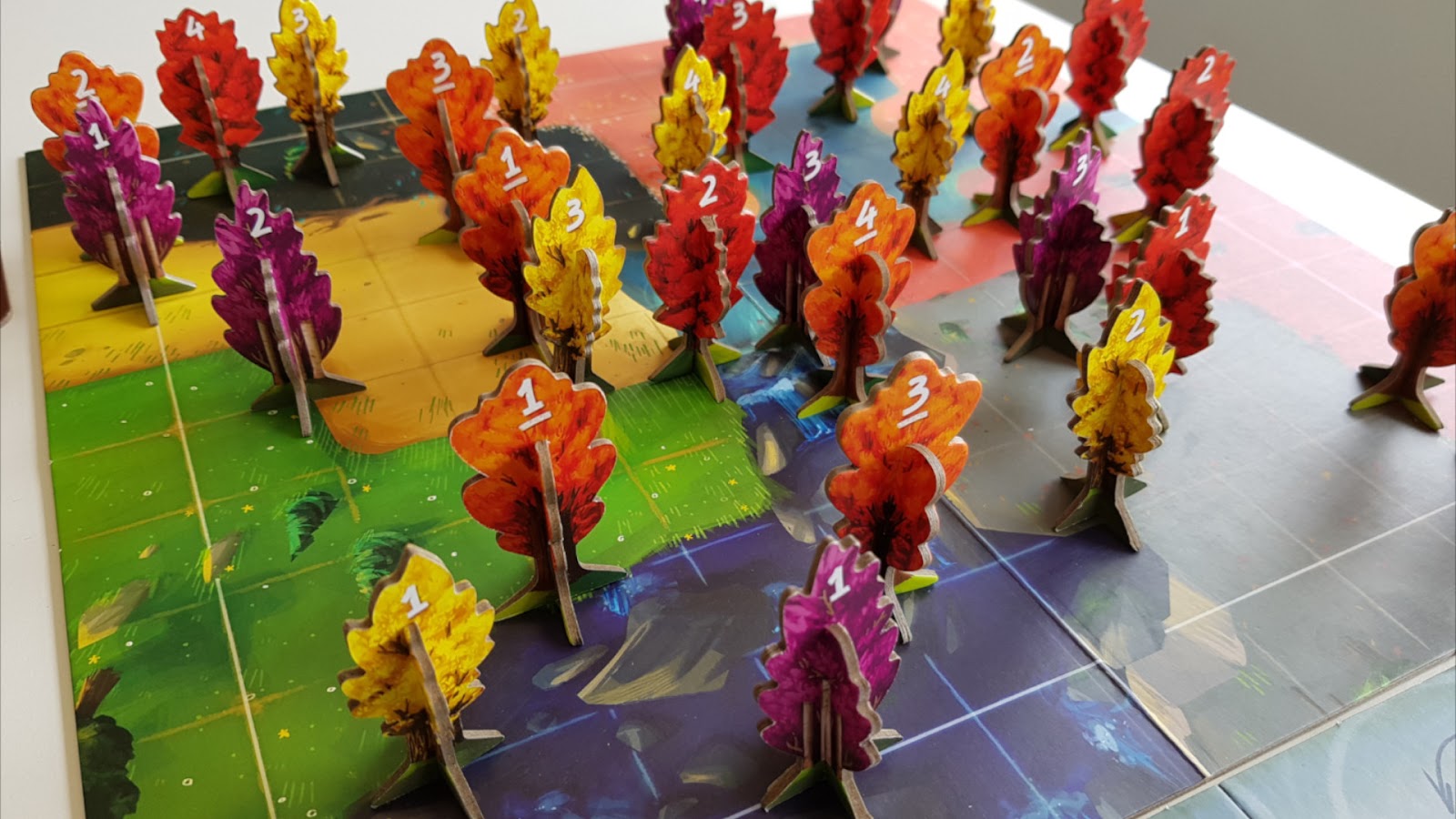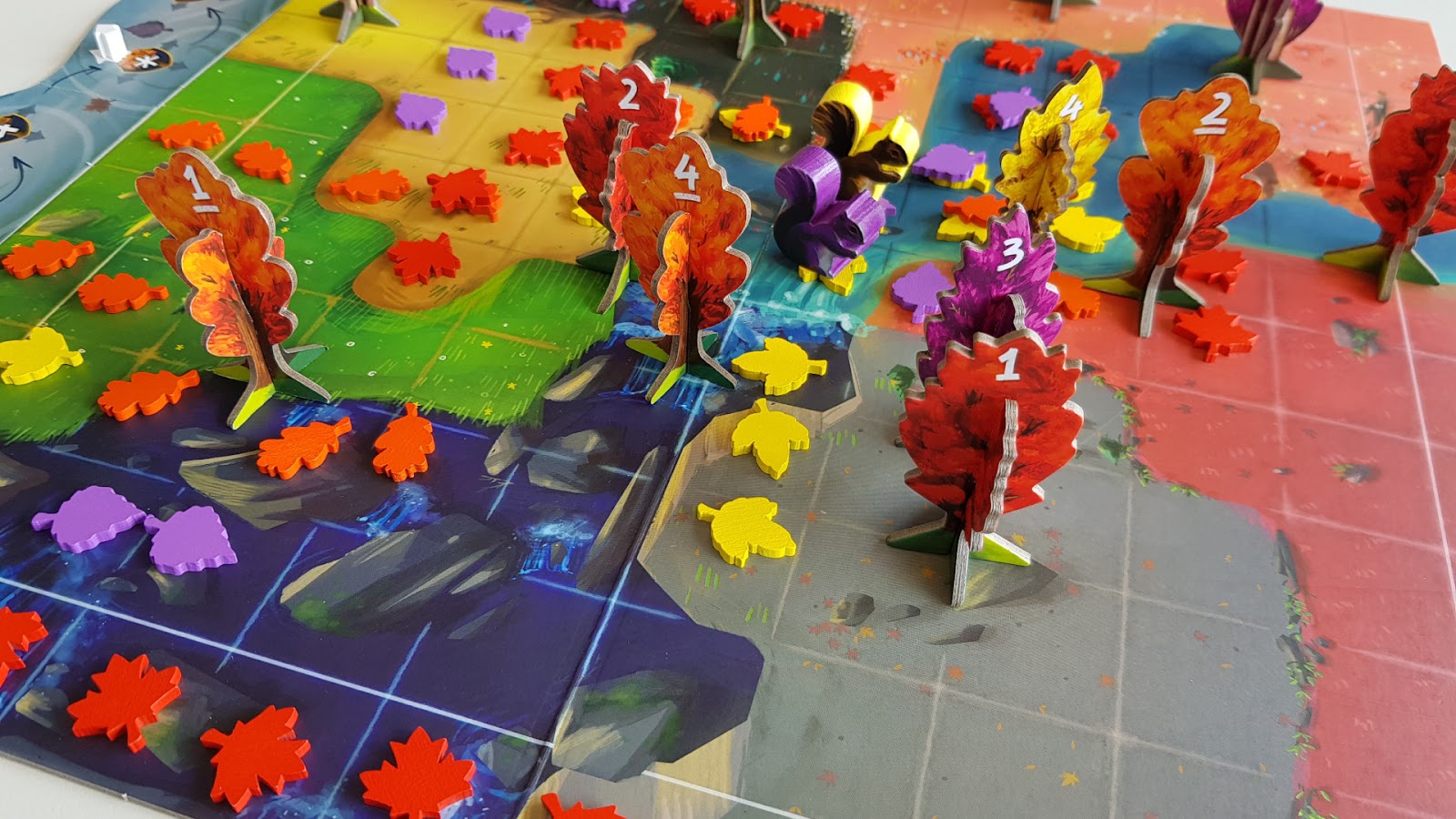Bosk: noun
a small wood or thicket, especially of bushes.
According to Urbandictionary.com it can also mean good, great, or enjoyable. (don’t look into Urban Dictionary to much here as it gets a little...spicy). So, is Bosk bosk? And if Bosk is bosk, how bosk is it? And, if a squirrel jumps out of a tree in Bosk and lands on your pile of leaves how bosking annoying is it?
Played over four seasons, the aim of the game is to grow and nurture a National Park. However, the particularly interesting point of this game comes from the fact that you score points in summer and winter and that in each season the way your score is different and is in part set up by the other.
In Bosk, there are two types of area control going on. Over the first half of the game you’re more concerned with the ranking of your trees (they are marked 1 - 4 with 2 of each). Ensuring that your have an even distribution of trees throughout the forest, but with the highest overall score of trees along as many paths as possible.
The start of this game is odd. It's a blank canvas, your first move, planting your first tree, and maybe even the first two or three feels...random, unrestricted. In many ways your very first choice feels unimportant. At least at the time you make it,because which tree and its location is without any context, yet. We're all gamers here and deep down you know it it does matter, but you won’t see why right now.
But then more trees come down.
And then more.
Moments ago the board was empty, now it’s chocked full of colourful cardboard trees. In this autumnal chaos it all becomes clear. A sort of The Pointillism-style image emerges now, each choice is methodical, considered, careful. It's at this point you see the pattern, you see the opportunities. The mistakes.
How long it takes to get to this point will depend on how many times you’ve played it. I’d expect for your second game you’ll be hitting this realisation by your second turn.
As with real life, the summer draws quickly to an end and we move into the first round of scoring, introducing the Hiker. The hiker walks along each path, points are awarded for the player with the highest score for each row and column and then we head into Autumn. The game twists, new components are drawn from the little boxes and we play Bosk “phase two”.
In the second, "heavier" half of the game it’s about leaf placement. The board is divided into six colured sections and you’ll be looking to have your trees artfully, and deliberately drop their leaves into all of them, covering your opponents leaves if necessary. In winter, you’ll score based on majority coverage in each section. Which trees drop their leaves and which way those leaves fall away from the tree are dictated by the very important and easily overlooked wind board.
The wind board very simply decides the direction of the wind, up, down, left and right, and at the beginning of Autumn it will dictate which trees drop their leaves, with turn one being a tree numbered one, turn two a tree numbered two and so on. By the fifth round of Autumn though, players choose which tree drops its leaves and this is a really important consideration. Choosing which tree to keep back for later leaf droppage can make a huge impact. Keep your centralised trees for the end and risk leaves blowing off the edge of the board? Start at the edges and move inwards? Strike a balance somewhere between the two
In fact, Bosk is full of these little important considerations. But, they are all little decisions too. There are only two trees with the number one on them so your choice really is one, or the other. However, next you must decide how many leaves to drop...
Another simple and interesting choice to make. Choosing between two and up to eight leaves. Go big early and carve up the landscape, or keep those big numbers back for later use in covering up your opponents and swinging the game in your favour in the final turns. In this phase of the game, play gets nasty. Covering a leaf costs you one of your own, but it can be so worth it, not only for the look on your opponent’s face, but these coloured areas are deceptively small, and one leaf can tip the balance between first and third place.
Autumn is a time for planning, for adapting, reacting, for taking advantage of openings and “mistakes” by your opponents.
This player interaction never feels especially spiteful or malicious, after all, the leaves must fall somewhere (just because it doesn’t feel malicious doesn’t mean placing leaves over your opponent’s doesn’t induce a certain amount of glee). Except the squirrel.
The squirrels are bastards. Squirrels trump all stacks of leaves and can’t be covered up meaning they are a great way to stake a claim on an area and are fantastic example of a Dick Move.
As the game progresses you can be haunted by past choices (not so much that a little careful planning can’t mostly mitigate), and with each turn, where you really only have one decision to make, you very quickly become aware of how important each decision is, and how the placement of a tree or a leaf can have an impact on the rest of the game.
I love the escalation of this game, I feel like I’m building up to something, the tactility of collectively planting a forest (or should that be bosk?), of seeing opportunities for easy points, or planting a “threat”. The spread and movement of the leaves in the second half of the game as players vie for control adds enough interaction and spice to an area control game without ever tipping into being nasty or overly competitive. There’s enough going on in this game to keep veteran gamers engaged but it also remains rule-simple enough to be a valid gateway game choice.
Playing Bosk, you’ll be quickly drawn into how stunning it looks on the table, you’ll be waylaid by how small each choice is at the start of the game and before you know it, you’re lost in the woods. These small steps each take you further into the game and into more considered choices. An apt metaphor for Bosk would be to say that each choice is a seed, seemingly small and simple, yet inside it has the possibility for something grand.
This review is based on a full retail copy of the game












.png)








0 comments:
Post a Comment